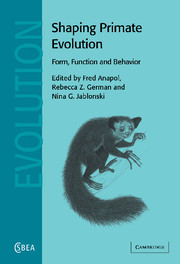Book contents
- Frontmatter
- Contents
- List of contributors
- Preface: shaping primate evolution
- 1 Charles Oxnard: an appreciation
- Part I Craniofacial form and variation
- Part II Organ structure, function, and behavior
- Part III In vivo organismal verification of functional models
- Part IV Theoretical models in evolutionary morphology
- 13 Becoming bipedal: how do theories of bipedalization stand up to anatomical scrutiny?
- 14 Modeling human walking as an inverted pendulum of varying length
- 15 Estimating the line of action of posteriorly inclined resultant jaw muscle forces in mammals using a model that minimizes functionally important distances in the skull
- Part V Primate diversity and evolution
- Index
- References
15 - Estimating the line of action of posteriorly inclined resultant jaw muscle forces in mammals using a model that minimizes functionally important distances in the skull
Published online by Cambridge University Press: 10 August 2009
- Frontmatter
- Contents
- List of contributors
- Preface: shaping primate evolution
- 1 Charles Oxnard: an appreciation
- Part I Craniofacial form and variation
- Part II Organ structure, function, and behavior
- Part III In vivo organismal verification of functional models
- Part IV Theoretical models in evolutionary morphology
- 13 Becoming bipedal: how do theories of bipedalization stand up to anatomical scrutiny?
- 14 Modeling human walking as an inverted pendulum of varying length
- 15 Estimating the line of action of posteriorly inclined resultant jaw muscle forces in mammals using a model that minimizes functionally important distances in the skull
- Part V Primate diversity and evolution
- Index
- References
Summary
Introduction
The inherent complexity of the masticatory apparatus is frequently simplified by resolving the jaw muscle forces into a single resultant vector (e.g., Weijs and Dantuma, 1981). This approach is reasonable because there is some evidence that essentially all the major jaw adductors are active at virtually the same time, at the point in the power stroke of the chewing cycle where the muscle forces are highest (e.g., Møller, 1966; de Vree and Gans, 1976; Weijs and Dantuma, 1981). The resultant force is therefore an appropriate consideration when constructing a static masticatory model of the chewing apparatus that deals with this critical point in the chewing cycle (e.g., Turnbull, 1970; Greaves, 1995). Moreover, this approach greatly simplifies the analysis of this complicated system.
While the magnitudes of the muscle forces are often of interest, two other characteristics of the resultant force vector (i.e., its orientation and position in space) are perhaps even more critical. These latter two features determine the vector's moment arm and thus the moment of the jaw muscle force. While the masticatory apparatus is a three-dimensional structure, the orientation of the vector of muscle force can sometimes be studied profitably in two dimensions in lateral view. From this vantage point, the vector points dorsally, from the lower jaw up to the skull, and can be inclined either anteriorly or posteriorly.
- Type
- Chapter
- Information
- Shaping Primate EvolutionForm, Function, and Behavior, pp. 334 - 350Publisher: Cambridge University PressPrint publication year: 2004
References
- 2
- Cited by



